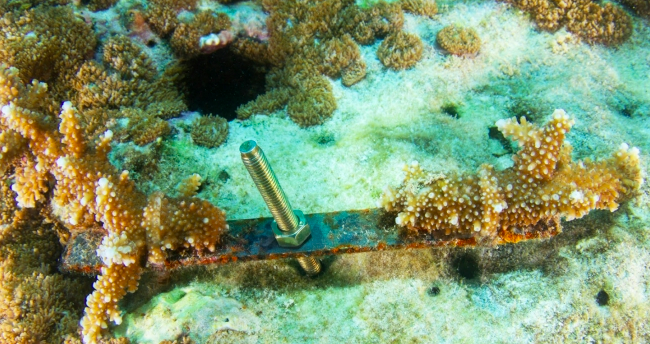Four Seasons Resort Seychelles Reef Restoration Project

Travel is not always good for the environment. Tourists trample over delicate flora and fauna, leave waste and add pollution. We don’t have to choose one or the other though, and I love reading about companies that make strides to help nature flourish. One such story is that of the Four Seasons Resort in the Seychelles. Previous projects have included monitoring coral bleaching and rescuing endangered hawksbill turtles. Along with marine education partner wiseOceans, they are now launching a project to protect 100,000 square feet of limestone reef in the resort’s bay.
The Seychelles coral reefs experienced El Niño warming in the 1990’s, when the top layers of the sea rose several degrees and stayed that way for months. The high temperatures were too much for the coral and it expelled the algae living in its tissues (coral bleaching). The reef has been in recovery ever since, and the Petite Anse Reef Restoration project aims to speed up the reef’s recovery.
Small pieces of broken coral from events like waves crashing will be collected from the ocean floor and brought to land. They’ll be attached to metal strips and then brought to the coral nursery in the sea which consists of coated iron frames. The coral will be given 9 to 12 months to grow safely, and then securely transplanted to bare areas of the reef. Those will hopefully grown into happy and healthy coral colonies that will provide food and shelter for animals like turtles. The goal is to transplant a total of 16,000 coral fragments by June 2017.
The Four Seasons Seychelles is excited about their new project, and it sounds like a wonderful endeavor. Reef Restoration Project Officer Tania Militello says, “There are many coral-growing or coral-nursery projects around the world, but this new method we are using here in the Seychelles has been designed specifically for the reef in question. Unlike similar projects in Maldives, for example, this area is not protected by an outer reef barrier and the resulting wave action means that all components of a coral-growing project here must be secured down. Coral fragments grow successfully when they are kept very still, so being extremely secure was a key aspiration when developing this methodology. The transplanted coral fragments will enhance the natural reef, increase the existing coral cover, and continue to thrive without intervention in the coming years.”
Here is a link to a list by Blue Oceans with some other ways you can help prevent coral bleaching.
Update: I was contacted by the folks involved in the project, and their site is now live. Click here to get the latest updates on the Reef Restoration Project.

Hi! Our project site is live here http://fourseasonsreefaction.com/ 🙂
Thanks for the update Caroline! I’ve added the link so readers can follow along.